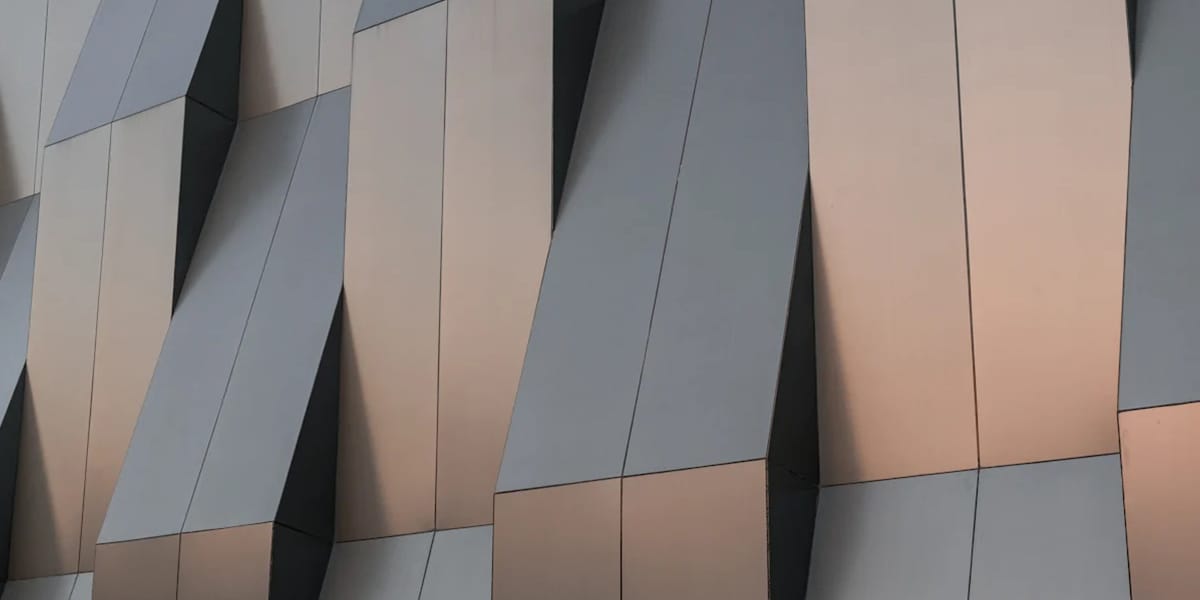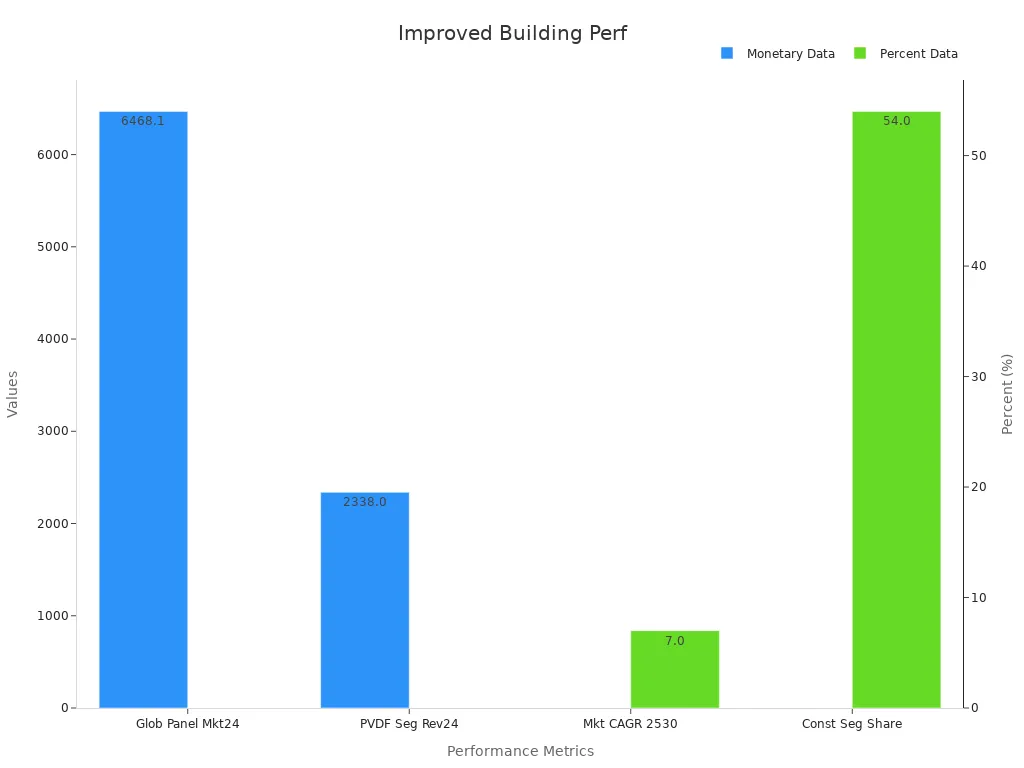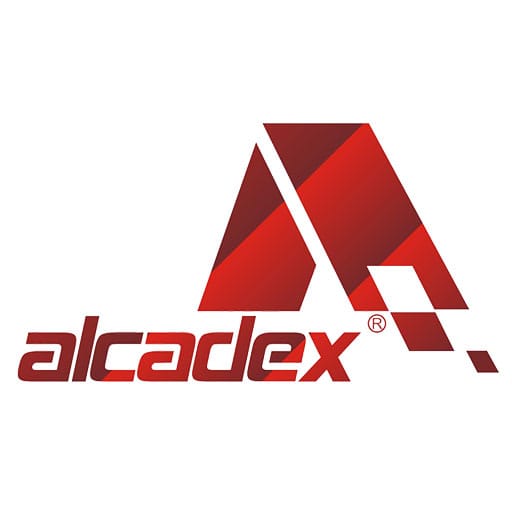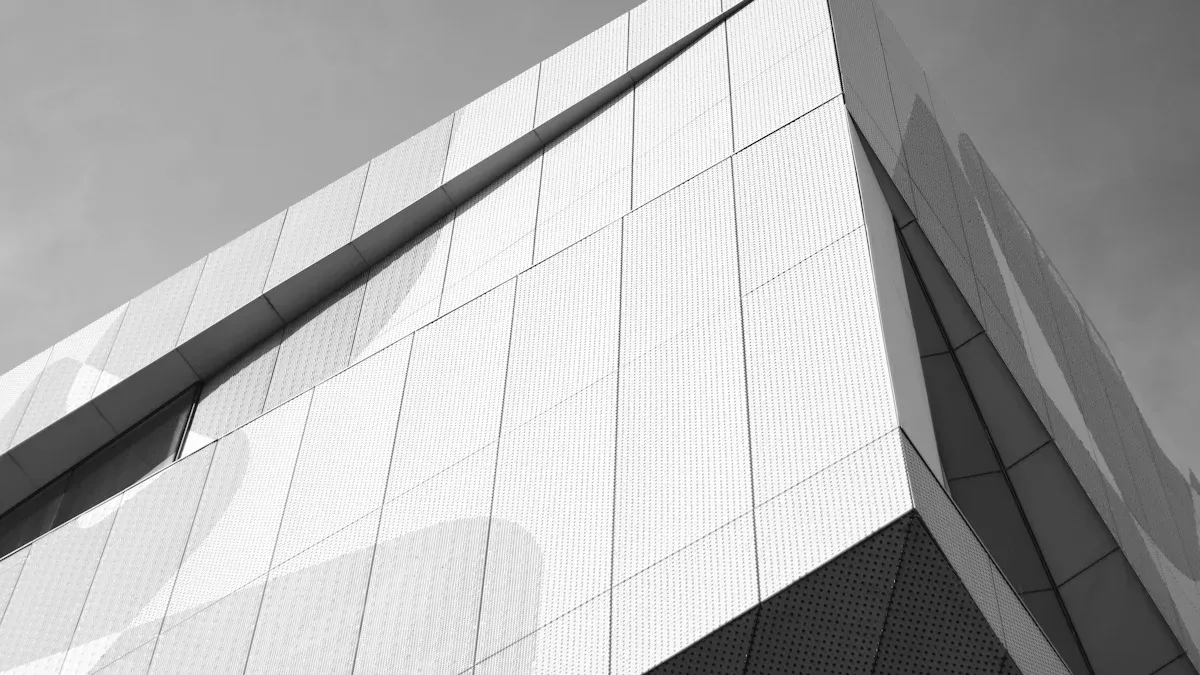
24 Jul What Are Anodized Aluminum Composite Panels and Their Key Features
Table of Contents
Anodized aluminum composite panels have two aluminum sheets and a core that is not aluminum. The anodizing process makes the surface hard and protective. This surface helps anodized aluminum composite panels stay strong and not get damaged easily. They are stronger than regular aluminum composite panels. Many architects and builders pick them because they can be used in many ways. Their design and finish help them last longer and look nicer in different projects.
Key Takeaways
Anodized aluminum composite panels have a tough oxide layer. This layer keeps them safe from rust, scratches, and weather. It helps them last longer than normal panels.
These panels have two thin aluminum sheets. There is a non-combustible core in the middle. This makes them strong and light. They are also safe from fire. Builders use them in many projects.
The anodizing process helps paint and glue stick better. This keeps the panels strong and looking nice for a long time.
Anodized panels do not fade or get damaged by sunlight. They also stand up to bad weather. Their color and finish stay good for many years.
These panels can be used in many ways. People use them for building facades, inside walls, signs, and decorations. They are safe, last a long time, and look nice.
Anodized Aluminum Composite Panels
Structure
Aluminum composite panels have layers stacked together. Two thin aluminum sheets are glued to a plastic core. Each aluminum sheet is about 0.5 mm thick. The core is usually between 3 mm and 5 mm thick. This sandwich design makes the panels strong and bendy. The aluminum gives a shiny, metal look. The core helps keep the panel steady and light.
For anodized aluminum composite panels, only the outside aluminum gets anodized. Anodizing puts a special oxide layer on the metal. This layer keeps the aluminum safe from rust and scratches. It also lets the surface take on different colors and finishes. Before anodizing, workers seal the layers. This keeps the liquid away from the core. Sealing is needed to keep the panel tough and safe.
Note: Anodized aluminum composite board often has a core that does not burn. This makes it safer for buildings where fire safety is important. Many panels use a core made from minerals that do not burn or give off bad fumes. This helps the panels meet strict safety rules.
The table below lists types of anodizing and what they do:
Anodizing Type | Electrolyte Used | Oxide Layer Characteristics | Thickness Range (microinches) | Key Benefits and Applications |
|---|---|---|---|---|
Type I | Chromic Acid | Thin barrier oxide film, dielectric, non-conductive | 20 – 100 | Good corrosion resistance, minimal dimensional change, suitable for aerospace, acts as primer for paint/adhesive |
Type II | Sulfuric Acid | Porous oxide film, dielectric, non-conductive | 100 – 1000 | Decorative applications, dye absorption, improved abrasion and corrosion resistance, architectural and consumer uses |
Type III | Sulfuric Acid (hard anodizing) | Thick, hard, porous oxide film, dielectric, non-conductive | > 1000 | High wear and abrasion resistance, industrial and military applications, may affect tight tolerances, excellent durability |
The anodic layer sticks tightly to the aluminum. This stops it from chipping or peeling off. The tiny holes in the surface help dyes and glue stick better. Sealing these holes makes the panel resist rust and keeps colors bright.
Differences from Standard Panels
Anodized aluminum composite panels are different from standard ones because of their surface. Standard panels have paint or a coating on the aluminum. Anodized panels have a hard oxide layer made by a special process. This layer is much tougher than paint or normal coatings.
Tests show anodizing changes the aluminum’s surface. It makes tiny holes and rough spots. This helps glue stick better and makes the panel stronger when joined with other things. For example, tests on aluminum alloys show anodized surfaces hold glue better, even with heat. The rough surface also helps paint stay on longer.
Anodized aluminum composite panels fight rust and scratches better than standard panels. The oxide layer protects against water, chemicals, and sunlight. This helps the panels last longer and look good over time. Sometimes, adding a silane coating with the anodized layer makes the panel even more rust-proof.
🏢 Tip: Builders often pick anodized non-combustible core composite board for jobs that need safety and strength. These panels follow strict fire rules and last a long time.
Studies show anodized panels stick together better than non-anodized ones. This means the layers do not come apart easily. Anodizing can make the panel a little less tough against hits, but the extra strength and long life make anodized aluminum composite panels a great choice for hard jobs.
Non-combustible metal composite board and anodized non-combustible core composite board are used a lot in new buildings. They mix the safety of a non-combustible core with the strength and nice look of anodized aluminum. An aluminum metal composite panel with an anodized finish looks smooth and works well for many years.
Anodizing Process

What Is Anodizing
Anodizing is a process that changes aluminum’s surface. Aluminum becomes the anode in a special cell. Workers put aluminum in a tank with an electrolyte like sulfuric acid. They send electricity through the tank. This makes the aluminum’s surface react and form a strong oxide layer. The oxide layer is part of the metal, not just on top.
Before anodizing, workers clean the aluminum well. They remove dirt and oil by degreasing, etching, and using acid. This helps the surface get ready for anodizing. The kind of acid, the temperature, and how long it stays in the tank all matter. For example, sulfuric acid anodizing makes a layer with tiny holes that can take dyes. Chromic acid anodizing makes a thinner layer that conducts electricity better.
Sulfuric Acid Anodizing (Type II): Makes a thick layer that can take dye and stops rust.
Chromic Acid Anodizing (Type I): Makes a thin layer that conducts electricity, good for electronics.
Hard Anodizing (Type III): Makes a very hard and thick layer for tough jobs.
Note: The tiny holes in the oxide layer can hold dyes and sealants. Sealing with hot water closes the holes and helps stop rust.
How It Improves Panels
Anodizing gives aluminum composite panels many good things. The oxide layer keeps the surface safe from rust, scratches, and chemicals. This helps the panels last longer and look new. The process also lets makers add different colors and finishes. This helps designers match panels to many looks.
The anodized layer makes the panel stronger and better against weather. It also adds insulation for heat and electricity. The thickness and shape of the oxide layer depend on the acid, temperature, and voltage. A thicker layer protects better and can be up to 100 micrometers.
Anodizing also helps glue and paint stick to the surface. This means the panels stay strong when joined with other things. The process makes the panels a good pick for buildings that need safety and style. By making panels tougher and better looking, anodizing improves how aluminum composite panels work.
Features of Aluminum Composite Panels
Durability
Aluminum composite panels are very tough in buildings. The anodizing process makes a layer with tiny holes on the aluminum. This layer can be closed up to stop rust and keep dirt off. Scientists have tested these panels by rubbing and soaking them in liquids. These tests show that anodized panels do not wear out fast, even in rough places.
Anodized aluminum surfaces can clean themselves and do not get dirty easily.
The panels do not let ice build up and stay strong in cold.
Tests show that anodized panels hold together better and last longer.
Scientists use machines to bend and pull the panels. They check how much force the panels can take before breaking. These tests include bending to see how stiff the coating is. They also use special pictures to see how cracks start. The results show that anodized aluminum composite panels are strong and useful for many things.
Weather and UV Resistance
Aluminum composite panels do well in sun, rain, and wind. The anodized surface keeps the panels safe from weather and stops rust. This means the panels stay strong and keep their color for years outside. The oxide layer blocks water and chemicals, so the panels do not rust or lose color fast.
Color change from sunlight is measured in Delta E units. A value of 2.3 means people can just notice the change. Some panels only change by 5 Delta E units after ten years in the sun. This shows the panels keep their color and work well in bad weather. The panels also pass tests for wetness and cleaning, so they can handle tough washing and wet places.
Fire and Scratch Resistance
Safety matters a lot in building design. Aluminum composite panels with a non-combustible core are great at stopping fire. These panels pass hard fire tests, like the Canadian S134 test, which checks if fire spreads in tall buildings. The mineral core and aluminum layers help the panels meet fire rules.
Test Standard | Fire Rating | Key Features |
|---|---|---|
Canadian S134 | Passed | Good for buildings over 40 feet, follows the code |
GB8624-2012 | A2 | Hard to burn, makes very little smoke |
Panels tested with the GB8624-2012 standard get an A2 fire rating. This means they do not burn and make almost no smoke. The anodized surface also does not scratch easily, so the panels look new even in busy places. These features make the panels a smart pick for safe and fireproof buildings.
Appearance and Finishes
Aluminum composite panels come in many looks and finishes. Makers check each panel for dents, bends, and color. They use rules like AAMA 2603, 2604, and 2605 to make sure the finish lasts and keeps its color. People look at the panels from 10 feet away in daylight to find any problems.
Panels must not chalk, bubble, or fade.
Color is checked by comparing samples after years in the sun.
The finish must handle cleaners and stay smooth.
Color change is measured with ASTM D2244. If the color changes less than 2.3 Delta E units, most people cannot see it. Some panels only change a little after ten years outside. This shows that aluminum composite panels keep looking good and working well for a long time. Builders and designers can pick from many colors and textures, so these panels are useful and look nice.
Applications
 Building Facades
Building Facades
Anodized aluminum composite panels are used on building outsides. Many architects like these panels because they last long and look smooth. The panels can handle bad weather, sunlight, and pollution. This makes them good for homes and businesses. Builders use them on tall towers, malls, and schools. These panels help keep buildings quiet and save energy. They block noise and heat well. More people want these panels, especially where green building and new tech matter.
🏢 Tip: Anodized panels can be used for many things in building. They work for outside walls, room dividers, and ceilings.
Interior Uses
Inside, anodized aluminum composite panels make rooms look nice and work better. Designers put them on walls, ceilings, and as dividers in offices, hotels, and hospitals. The panels come in lots of colors and finishes. This lets people make cool designs. The panels are light, so they are easy to put up. They do not make buildings heavy. The panels do not scratch or stain easily. This is good for busy places like lobbies and hallways. Many inside projects use these panels because they fit many styles and last a long time.
Signage and Decorative Elements
Sign makers and decorators use anodized aluminum composite panels a lot. These panels are strong and can be used in many ways. You see them in outdoor signs, store displays, ads, and wall covers. The panels do not fade, rust, or get ruined by bad weather. This makes them good for inside and outside. Makers offer many finishes like matte, brushed, mirror, and colored. The panels can be cut, bent, or carved into shapes and designs. Many businesses, like car and tech companies, use these panels for logos and decoration. The panels have a smooth feel and even color.
Decorative Project Types | Performance Features | Surface Finishes |
|---|---|---|
Outdoor signs, displays, nameplates, decorative wall panels | Corrosion resistance, color stability, durability | Matte, brushed, mirror, colored |
Anodized aluminum composite panels have layers and a tough anodized surface. These panels give many good things:
They are light, so putting them up is easy.
They help save energy and lower bills.
They come in many looks for new buildings.
Experts say to pick panels with good coatings and fire-safe cores. This keeps people safe and makes the panels last longer. Weather can change how the panels look, but cleaning by pros can fix this. Builders should talk to experts before they begin their work for the best results.
FAQ
What makes anodized aluminum composite panels different from painted panels?
Anodized panels have a strong oxide layer made during anodizing. This layer protects the panel better than paint does. It stops scratches, fading, and rust. Painted panels have a coating that can chip or peel off after a while.
Can anodized aluminum composite panels be recycled?
Yes, you can recycle these panels. The aluminum layers and the core can both be recycled. Recycling these panels helps cut down on waste. It also supports green building and helps the environment.
Are anodized aluminum composite panels safe for use in schools and hospitals?
Anodized panels with a non-combustible core follow strict fire rules. They do not let out harmful fumes. Many schools and hospitals use them because they are safe and last a long time. These panels are also easy to clean.
How do you clean anodized aluminum composite panels?
Use gentle soap and water.
Wipe with a soft cloth or sponge.
Do not use strong chemicals or rough scrubbers.
Cleaning the panels often keeps them looking nice and stops dirt from building up.



 Building Facades
Building Facades